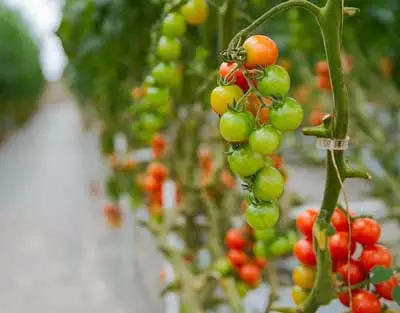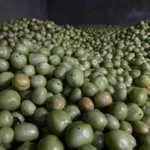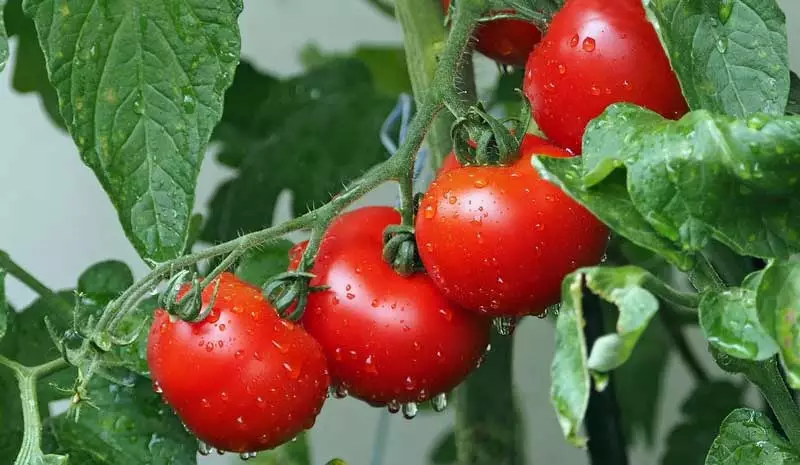Let’s talk about growing hydroponic tomatoes. I have already shared an article where we discussed how to grow lettuce in a hydroponic system. Today, I will walk you through the process of growing tomatoes in our homes. We will cover all aspects of growing a tomato plant from seed to harvest hydroponically.
Unlike growing lettuce, tomatoes are more complex when it comes to growing hydroponic tomatoes. I will tell you the reason why. It is because lettuce does not demand as many nutrients as we did in the last article, it requires nitrogen more than anything but tomatoes require all the macro and micronutrients in balanced quantities. Additionally, there are extra steps like pollinating the hydroponic tomatoes involved in growing a wine of hydro tomatoes.
As you must be knowing there are hundreds of tomato seed variants available in the market. We will be using the most common and easily available seed, the cherry tomato.
For your ease, I have also made a shopping list on Amazon that you can refer to for the things that I have discussed in this article.
Kratky Hydroponic Tomatoes Shopping ListStarting Hydroponic Tomato Seed
Seeds are the first thing that you need to start a garden, be it any plant doesn’t matter and tomato is no different so we start with a good selection of seeds, as I told you already I chose the cherry tomato variety, you can get it from Amazon under $7 and it is an indeterminate variety of tomato.
The indeterminate variety is a long season tomato, which means that the plant will keep growing tomatoes in small quantities throughout the year.
The seeds that I took are treated seeds. Why treated seeds? Because they also are very resilient to fungal and pre-emergent infections. The pre-emergents stage is before a plant germinates. You can go ahead with the untreated seeds but you need to be a little more careful in selecting the right infection-free medium.
So once you select the seeds now it is our turn to select a seed starting mix. The easiest mix you can find is either a peat moss based mixture or a coco peat-based mixture. If you are based in India then coco peat is easily available there and in the US and other parts of the world peat moss based mixtures are easily available.
The mixture should be inert if you are growing it in a hydroponic system. If you’re growing it in a conventional way or organic way you can add a bit of compost to the mixture but remember seedling seeds don’t require any fertilizer to germinate.
So the mix I use is just coco peat. You need to ensure that the salt content of the coco peat is lesser. It is always specified as a conductivity value or EC. It should be 0.5 or lesser the EC value of the coco the better.
Also Read “EC Meter Buying Guide plus best 5 suggestions“
If you don’t have cocoa peat we can still do it in whatever mix you get just to ensure that it is infection-free. You can also use perlite, vermiculite, whatever is available. So now once you have a grow media mix ready, you can always squeeze the mixture to get the extra water out. If it is not wet then just moisten it only a little bit so that there is no heavy water stagnation in the medium.
The starting medium should not be soggy wet. It should be just barely moist. Once the moisture is right seeds pop out anyway. You can use a propagation tray with 10 or 20 net cup holes so you could germinate 20 plants at once or if you are doing this for the first time and want to go for just 1 or 2 seedlings then you can directly sow the seed in the system.
For easy starting of hydroponic tomato seeds, you can use starter plugs. Those are very easy to use and transplant. In a propagation tray, you need to take the seeds out with a little bit of a knack.
Extra HH Tip: If you cover the germination tray or starter plugs with a poly film or sheet the chances of your seeds germinating successfully increase. This happens because the moisture is locked within the setup and acts as a breeding environment for the seeds.
Just keep checking after 2 to 3 days for any signs of germination and as soon as they germinate it is time for you to remove the sheet and expose them to good sunlight. Any delay in sunlight exposure can cause your seedlings to become lanky, eventually running the whole plant.
Make sure to monitor the seeds every 4-5 hours or on a daily basis to ensure they don’t get lanky.
Transplanting Hydroponic Tomato
Once the seedlings are up and exposed to good sunlight it is time for you to water them with nutrition, not plain water. From seedling to transplanting stage we are going to water these plants with a half-strength nutrient solution. The nutrition in the seed is only to get the seedling to germinate after that it is our responsibility to water them every day.
After about 20 to 25 days the seedling will be ready for transplanting into a permanent hydro setup. You can use anything that is available to you to build your own hydroponic system. You can transplant them into an NFT system or ebb and flow system.
The two most popular method of growing hydroponic tomatoes is the Dutch Bucket system and the Kratky method.
We have covered the Kratky method of growing lettuce. You can follow the same steps to grow your own Kratky tomatoes.
Just make sure that you are using the right mix of grow media and also that the drainage is perfectly working in your system. Drainage causes several issues, for example, the pH level can shoot up, damaging the leaves and other parts. Read how to control the pH of your nutrient solution here.
Also Read “DIY Mason Jar Hydroponics with Kratky Method – Easy and Cheap“
Adding Nutrient Solution
Once the transplanting is done you need to supply the nutrients regularly to the plant. Earlier we were using half-strength but now we can use the full strength. Tomatoes have a high intake of nutrients especially when they are in the vegetative stage. The two best nutrient mixes that I can recommend to you are the Flora Gro Blend and the Masterblend.
So we use growth nutrients till the point when the tomato plant starts to flower.
When the plant is starting to flower we switch to what is called a bloom nutrient solution. Bloom nutrients have different goals, one is to increase the plant in size and the other is to increase the fruit. Bloom nutrients have more potassium and it improves the fruit colour texture and sugar content.
So, from transplanting to flowering we continue to use the same nutrient that we used for seed germination but we used half strength before now we use a full-strength which will be about EC 2 to 2.5.
If you want very optimal results the watering can be done as per the sunlight falling on the plant which is usually highest during noon.
Training Hydroponic Tomato
Training is not a new concept in farming. All plants which wine out require this and you must have either done it or seen it already. The tomato seeds you just transplanted will grow at a rapid pace. The length of the wine could exceed 40 or 50 feet as well. But you may not have that much space in your garden or rooftop.
So, to tackle this issue we train the tomato plants to first grow vertically and then we redirect them to grow downwards. By using clips and ropes you can manually wrap the plant stems to the rope that you have tied to the ceiling. Once the plant makes its grip, it will automatically grow upwards.

Now, once it reaches the top you have to lower the plant. For this, you need to carefully bend the plant stem downwards and clip it to the second rope that you have put across. You will have to do this a couple of times before the plant learns how to navigate its ways through the ropes.
This method helps to grow much taller hydroponic tomatoes inside our home or on the terrace.
How long does it take tomatoes to harvest?
While you are already training your plants, it will start to yield a lot of tomatoes but the most difficult part in this is waiting for them to ripen. It takes almost a month for hydroponic tomatoes to come to a ripened stage.
In Cherry Tomato we also have to wait for the entire press to ripen. It’s not fun if you have just one red and all of the green. Waiting for the ripening is also essential but one thing to note down is the flavour, the sweetness, the acidity of the fruit depends on when you harvest them.
Most of the commercial tomatoes are harvested before they are ripe on plant and reach you when they are badly ripe and hence lose all their good qualities. While growing your own hydroponic tomatoes gives you the advantage to eating tomatoes that are ripened on the plant itself.
Also, Read “DIY 5-Gallon Bucket Hydroponic System to Grow Tomatoes”
Pruning
One additional step that you have to take care of is Pruning. There will be a lot of activity in your tomato plant once it grows into an adult. One thing that should concern you is the repeated growth of extra side branches (that we don’t need). Those side branches are actually called suckers. Will tell you why.
A hydroponic tomato plant is trained as a single stem and whatever branches emerge from the side, you will need to remove them as soon as possible. These are called suckers because they consume a lot of the nutrients that are intended for the ripening and flowering of the tomato plant. So, keep pruning those suckers and keep harvesting the batch as ready.
Learn “How to grow Hydroponic Basil Forever“
Pollinating Hydroponic Tomatoes
One difference between growing lettuce and tomatoes is that lettuce or green leafy vegetables don’t require any kind of pollination. In contrast, tomato plants grow flowers and in every growth, cycle pollination is required to grow the fruit. Either you can do that manually or get a pollinator from Amazon, I have included it in the shopping list as well.

So, one thing that you will have to do is do the pollination yourself. Yes, I am right. Now, because your hydroponic tomatoes are in some kind of controlled environment bees and insects cannot pollinate the flowers, so you will have to shake the stems gently that contain the blooming flower.
When you are doing that you will observe that a small white powdery like substance is falling from the flower. Yes, that is exactly what you have to do to pollinate hydroponic tomato plants.
FAQ
Do tomatoes grow well in hydroponics?
Yes, not just tomatoes but all vegetables grow well in hydroponics. This is because of the controlled environment and nutrient-rich solution used in hydroponics. Research has shown that hydroponic crops give 20-30% more yield on average as compared to traditional crops.
What tomatoes are best for hydroponics?
Indeterminate seeds are preferred if you want a continuous harvest. Cherry, Trust (F1 Hybrid), and Daniela are some examples of indeterminate varieties of tomatoes. If you are looking for speciality tomatoes and determinate yield then Plum Regal, Chiquita, Gardeners Delight, Sweet 100, etc are some breeds you can use.
Are hydroponic tomatoes healthy?
Yes, hydroponic tomatoes are healthy and 100% organic. If your hydroponic system develops some kind of fungus or bacteria then the crop gets affected. Washing off your NFT system every 7-10 days will help remove excess dirt or micro-organisms inside the system.
How long does it take to grow tomatoes hydroponically?
It takes around 3-4 weeks to grow hydroponic tomatoes. As the wine grows larger you will get a bunch of tomatoes ready to harvest every week. The determinate varieties may take a little longer depending on the environment and the whole wine will be ready to harvest.
Can I grow hydroponic tomatoes forever?
Yes, with the Kratky method, dutch-bucket system, and NFT system, you can easily grow tomatoes forever hydroponically. The key here is that the seed should be an indeterminate variant so that the crop keeps growing and also produces tomatoes.
Do Hydroponic Tomatoes taste good?

Yes, Hydroponic tomatoes taste good. One reason is that you consume them directly from the plant when they are ripe. Instead, when you buy from a grocery store, the tomatoes are actually harvested much earlier and then ripened artificially. So, enjoy your organic tomatoes.
What should be the nutrient PPM concentration and EC for hydroponic tomatoes?
The ideal PPM concentration for hydroponic tomatoes is between the 900-1100 range. The major nutrients required for hydroponic tomatoes are N: 140 ppm, P: 50 ppm, K: 350 ppm, Mg: 50 ppm, Ca: 150 ppm, S: 150 ppm. The EC value should be between the 1.9-2.5 range.

